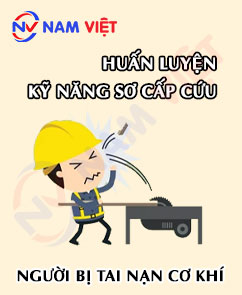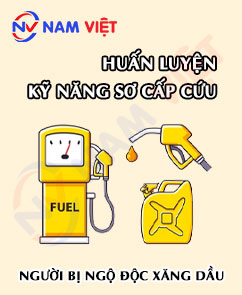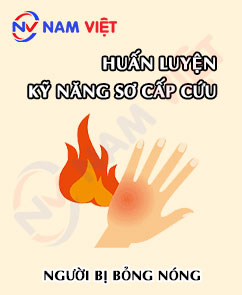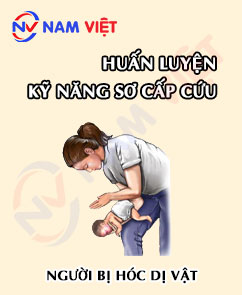First aid training for individuals injured in mechanical accidents
500,000 ₫
Note: The above price is calculated per person. Prices may vary depending on the number of participants in the course and market fluctuations. For more accurate pricing, please refer to the price list or contact our consulting staff directly.
Table of Contents
Toggle1. Identifying Mechanical Accident Victims
a. Cases of mechanical accidents
Mechanical accidents can occur in many areas, including industry, transportation, construction, agriculture, and daily life. Some common cases of mechanical accidents include:
- Industrial machinery accidents: These are the most common when workers operate in factories, plants, or industrial environments. Accidents may occur due to technical faults in machinery, lack of experience, or violations of safety procedures.
- Traffic accidents: Another common scenario involves collisions with trucks, excavators, cranes, or getting crushed during operation.
- Construction accidents: Occurring during the building of houses, bridges, roads, or other structures, these accidents may result from unsafe building materials, lack of protective equipment, or safety procedure violations.
- Agricultural accidents: Farmers working with machinery such as plows, tractors, or harvesters may be injured if safety regulations are not followed.
- Household accidents: Daily use of appliances like blenders, lawnmowers, planers, or home repairs can also lead to injuries.

b. Signs someone is about to be involved in a mechanical accident
Recognizing signs of an impending mechanical accident is crucial to prevent or reduce injuries and property damage. Some signs include:
- Negligence or lack of focus: Workers must concentrate when operating machinery to follow procedures and avoid mistakes. Lack of focus, overconfidence, or careless actions may lead to accidents.
- Lack of knowledge or experience: Inexperienced operators may damage machinery or cause accidents.
- Safety devices malfunctioning: Faulty or inoperative safety equipment can result in injuries.
- Fatigue from long working hours: Tired workers lose focus and are more prone to accidents.
- Violation of safety procedures: Ignoring proper operating procedures can cause accidents to oneself or others.

c. Assessing the condition of mechanical accident victims
Assessing the condition of a mechanical accident victim depends on the severity of the accident and the injuries sustained. Common conditions include:
- Pain and discomfort: Victims may experience pain from injuries or impacts.
- Bleeding: Deep wounds or severe injuries can result in significant blood loss.
- Swelling: Injuries or impact may cause swelling at affected areas.
- Fractures: Victims may have broken bones or joint/muscle injuries.
- Paralysis: Compression or damage to nerves or blood vessels may cause numbness or loss of sensation.
- Shock: Severe accidents, blood loss, serious injuries, or endocrine imbalance may cause the victim to go into shock.

d. Golden time for mechanical accident cases
The golden time is the critical period to save lives and minimize complications for mechanical accident victims. It usually refers to the first 60 minutes after the accident until professional medical care is received.
During this golden time, prompt medical evaluation and treatment of severe injuries are essential to improve recovery and reduce complications. Adhering strictly to the golden time increases the likelihood of the victim’s recovery.
Initial first aid measures can help victims during the golden time, including airway checks, cardiovascular assessment, and emergency rescue. Authorities should also be notified to ensure the victim is transported to a specialized medical facility as soon as possible.
2. Overview of First Aid Training for Mechanical Accident Victims
a. What is a first aid training course?
A first aid training course is designed to teach learners basic and advanced first aid skills. It includes lessons and practical exercises on handling emergencies such as cardiac arrest, respiratory failure, poisoning, injuries, and other urgent situations.
The purpose of the course is to equip learners with the necessary skills to respond to emergencies, minimize harm to themselves and others, increase survival chances, and ensure timely medical care.
REGISTER FOR BASIC FIRST AID TRAINING
b. Training duration
Initial first aid training:
- For employees: 4 hours.
- For first aid and emergency responders: 16 hours (2 days).
Periodic first aid training:
- For employees: 2 hours.
- For first aid and emergency responders: 8 hours (1 day).
c. Course content
- Basic principles of first aid and on-site emergency care
- Wound bandaging (principles, tools, techniques)
- Temporary bleeding control techniques (principles and methods)
- Temporary fracture stabilization techniques (principles and tools)
- Cardiopulmonary resuscitation (recognizing cardiac arrest, airway clearance, breathing support, CPR guidance)
- Burn management (assessing cause and severity, on-site first aid)
- Safe victim transportation with and without stretchers for initial care
- Specific emergency care scenarios:
- Electric shock
- Drowning
- Chemical accidents
- General guidance on first aid kit use
- Practical exercises for all content areas
d. First aid training certificate
Upon completing the course, learners receive a certificate confirming completion of the first aid training program under the Group 2 training framework as specified in Appendix IV, Decree 44/2016/ND-CP. The certificate is valid for 1 year.


3. Essential Tools for a First Aid Kit in Case of Mechanical Accidents
Carrying a first aid kit during hazardous work activities is essential for timely response to mechanical accidents. The basic tools in a first aid kit for mechanical accidents include:
- Elastic bandages: Used to dress wounds, support tendons, and stabilize joints.
- Dry gauze and cotton: Used to clean and wipe wounds.
- Face masks and medical gloves: Used to ensure safety when approaching victims.
- Cutting scissors and pliers: Used to cut or clamp materials such as cables or metal.
- Cleaning cloths and saline solution: Used to clean wounds and prevent infection.
- Tape and adhesive: Used to secure rigid materials and stabilize rescue bandages.
- Oxygen: Used to assist breathing for victims who are not breathing.
- Rectal mirror: Used to examine wounds in the anal area.
- Antibiotics and painkillers: Used to control infection and relieve pain for the victim.
REGISTER FOR BASIC FIRST AID TRAINING
4. First Aid Procedure for Mechanical Accident Victims
The first aid procedure for mechanical accident victims includes the following steps:
- Assess the victim’s condition: Check the victim’s condition and vital signs. If the victim is not breathing or has no pulse, the rescuer should immediately start CPR.
- Call for help: If the victim’s condition is serious, contact emergency services or call 115 to request professional assistance.
- Treat wounds: Examine the victim’s wounds, ensure bleeding is controlled, use elastic bandages to dress wounds, support tendons, stabilize joints, and prevent unnecessary movement.
- Treat shock: If the victim is in shock, elevate the victim’s legs to help blood flow to the brain and other vital organs.
- Provide appropriate medication: Give the victim antibiotics or painkillers to control infection and reduce pain.
- Transport to hospital: If the victim’s condition is serious, transport them to a hospital as quickly as possible for professional medical care.
- Record and monitor: Document the entire first aid process and continue monitoring the victim until hospital care is available.
5. Benefits of First Aid Training
First aid training provides many important benefits for individuals and the community:
- Saving lives in dangerous situations: First aid skills enable trainees to save people whose lives are at risk, such as cardiac arrest, respiratory arrest, poisoning, injuries, and other emergencies.
- Helping others learn first aid: Trained individuals can share knowledge and experience with others, enabling the community to protect itself and reduce fatalities in emergency situations.
- Reducing waiting time for rescue: When trained first aiders handle emergencies on-site, waiting time for rescue teams is minimized.
- Enhancing response and reducing stress in emergencies: First aid training equips learners to respond accurately and quickly, lowering stress and anxiety while awaiting help.
- Increasing survival rates and reducing fatalities: Timely and proper first aid improves survival chances and reduces complications or deaths in emergencies.

6. First Aid Training Capacity of An Toan Nam Viet
An Toan Nam Viet is a reputable and high-quality first aid training center in Vietnam. Training sessions are conducted continuously at workshops, factories, and construction sites nationwide (all 63 provinces of Vietnam).
REGISTER FOR BASIC FIRST AID TRAINING
Training Certification
- An Toan Nam Viet has been inspected and certified by the Department of Safety under the Ministry of Labor – Invalids and Social Affairs for occupational safety and hygiene training. Within the Group 2 training program, the first aid skills module is included, further strengthening our capacity in first aid training.

Training Materials and Lectures
- Before being used in first aid courses, training materials are reviewed to ensure accuracy and practical effectiveness.
- Instructor methods are standardized according to An Toan Nam Viet standards, developed by experts in first aid training to maximize knowledge retention for learners.
Facilities
- Controlling factors in the training room enhances teaching efficiency and knowledge absorption.
- Our training facilities provide spacious classrooms meeting standards for space, lighting, and training equipment.
7. Nationwide First Aid Training Centers
An Toan Nam Viet is one of the most reputable and professional organizations for first aid training in Vietnam. With experienced instructors, modern equipment, and high-quality programs, the center has become an ideal destination for those interested in protecting lives and health.
By attending courses at An Toan Nam Viet, you will learn basic and advanced first aid skills, from CPR for cardiac arrest, respiratory arrest, poisoning, injuries, to handling other emergency situations. The program is flexible and suitable for all learners, including adults, children, medical staff, rescue personnel, and the general public.
An Toan Nam Viet’s first aid training not only teaches essential life-saving skills but also fosters awareness to protect your own life and health as well as those around you. Training by experienced and highly qualified instructors ensures confidence and readiness for any emergency situation.
Register for first aid courses at An Toan Nam Viet to protect your life, health, and the community.
2 reviews for First aid training for individuals injured in mechanical accidents
No comments yet












maituyet.cuong12
Good first aid training center! Satisfied
Nguyễn Ngọc Thông
Cung cấp cách dịch vụ An Toàn Lao Động rất tốt nhé!